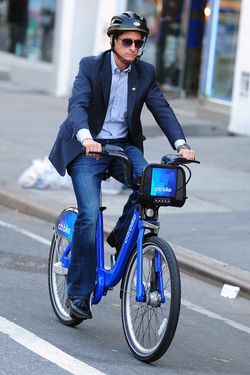Weiner on Bike Policy: Small Talk, Small Stick
Yesterday, riders at the sixth annual Tour de Queens got a preview of Anthony Weiner’s proposal to introduce new city tax breaks for businesses that help employees bike to work. It’s one of the meager transportation proposals in his policy book, “Keys to the City.” There are already plenty of financial incentives to bike — walking is the only mode of transportation that’s cheaper — so, understandably, riders were much more interested in hearing from Weiner about how he’ll make streets safer. But his ideas about street design were similarly underwhelming.

After taking a turn at the mic to hype the tax benefit, Weiner jawboned with about a dozen Tour de Queens participants, including myself, about how he’d make streets safer for biking. He was amiable throughout, but while he insisted he was only joking when he told Mayor Bloomberg, in 2010, that he would “have a bunch of ribbon-cuttings tearing out your f—ing bike lanes,” he also made it clear that he would, in fact, rip out bike lanes if elected, starting with the Broadway bike lane that runs close to his current residence in Gramercy.
Whereas fellow mayoral aspirant John Liu has said that bike lanes make sense in Manhattan but not elsewhere in New York, Weiner staked out the inverse position: He’ll remove bike lanes in Manhattan while adding them in the other boroughs. When I mentioned the dramatic reduction in injuries on major avenues following redesigns for bike and pedestrian safety, he said that all of his decisions would be “data-driven.” But he wasn’t swayed by the well-documented improvements in safety that I brought up.
In his view, projects like the Times Square pedestrian plazas and Manhattan protected bike lanes aren’t calming traffic, they’re delaying motorists. “When you create an enormous amount of congestion,” he said, “you’re going to have fewer injuries.” Any safety gains, he said, have to be weighed against the added congestion.
Of course, if you look at the numbers, these redesigns aren’t delaying motor vehicle traffic. They’re reducing the incidence of speeding and compelling drivers to take turns more carefully. Manhattan remains a terrible place to drive — same as it ever was. The difference with the new plazas and bike lanes is that now it’s a better place to walk and bike.
Throughout the conversation, Weiner tried to portray himself as a reasonable guy, someone who would take the “divisiveness” (his word) out of bike policy. But listening to him frame successful street redesigns as radical interventions, it seemed like a Weiner mayoralty would mainly take the effectiveness out of bike policy. He never articulated a clear position about how to make streets safer beyond the promise to add more Barnes Dances (all-way, exclusive pedestrian signals).
It felt like a step backward for Weiner since his appearance at the first Tour de Queens in 2008, when he told the crowd, “We still have to make this city a much more bike-friendly town.”
Weiner’s failure to think big became all too apparent when the conversation shifted to Queens Boulevard. He’d said he would add bike lanes outside Manhattan, and Queens Boulevard is arguably the single most important bike route in the other boroughs, but it’s a dangerous, traffic-plagued disaster. Would he add a bike lane on this incredibly wide east-west thoroughfare? Watch Weiner struggle to envision such a possibility: